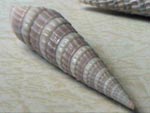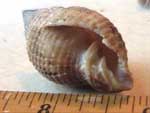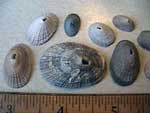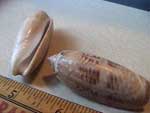 There are two varieties of species in my shell identification book(s) which fit the shells in the photo. However, the smallest variety, Jackknife clam Ensis minor, 2-3" is listed as commonly found from Florida to Texas.
There are two varieties of species in my shell identification book(s) which fit the shells in the photo. However, the smallest variety, Jackknife clam Ensis minor, 2-3" is listed as commonly found from Florida to Texas.The larger variety, Green Jackknife Clam Solen viridis, 2" is found from Rhode Island through Northern Florida and Gulf Coast.
Razor-Shaped jackknives (Solenidae)
Atlantic jackknife Ensis directus (Conrad)
Description: (5 inches) Long, slender shell six times as long as high. Slightly curved with blunt ends. Looks like an old-fashioned razor. Cardinal and lateral hinge teeth at back of beak.
Color: Whitish exterior. White and violet interior. Shiny olive to brown periostracum.
Habitat: Lives in sounds and offshore burrowing in muddy sand. Common on ocean beaches, particularly above Cape Hatteras. Often found in shell drift at tide line.
Range: Canada to South Carolina.
Notes: This species is excellent tasting but not fished commercially. It burrown rapidly into sand and swims in an erratic manner. Edges of the shell are sharp.
Minor Jackknife Ensis minor (Dall)
Description: (5 inches, but most are about 1 3/4 inches)
Similar to Atlantic jackknife except smaller, more fragile and possibly more pointed at the toothless end of the hinge. About nine times as long as high.
Color: Whitish exterior. Interior stained with purple. Reportedly paler than the Atlantic Jackknife.
Habitat: Lives offshore burrowed in muddy sand at depths to about 60 feet and in moderate- to high-salinity estuaries. Commonly washed onto ocean beaches.
Range: New Jersey to Texas.
Notes: Also called a dward razor clam or common razor clam. It is often eaten by wading birds. Authorities question whether this might be a subspecies of the Atlantic jackknife. Most small specimens found below the Cape Lookout area should be the minor jackknife.
Green Jackknife Solen viridis (Say)
Description: (1 1/2 inches) Long, slender shell similar to the Atlantic Jackknife but shorter and less curved. Four or five times as long as high. Hinge line almost straight but possibly slightly curved. One cardinal tooth in hinge of each valve.
Color: Grayish white exterior and interior. Yellowish green periostracum.
Habitat: Lives in sounds and intertidal sand bars. Occasionally washed onto sound and ocean beaches in shell drift at tide line.
Range: Rhode Island to Texas.
Notes: See Atlantic Jackknife Notes
Source: Seashells of North Carolina, North Carolina Sea Grant College Program
Related Posts: Atlantic Jackknife Clam














No comments:
Post a Comment